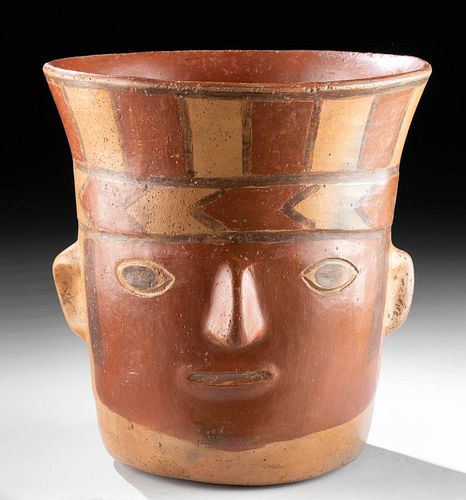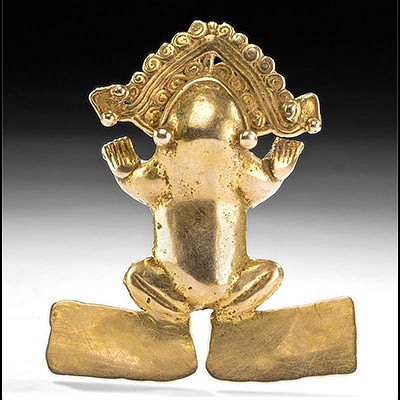Huari Polychrome Portrait Kero
Lot 81a
About Seller
Artemis Gallery
686 S Taylor Ave, Ste 106
Louisville, CO 80027
United States
Selling antiquities, ancient and ethnographic art online since 1993, Artemis Gallery specializes in Classical Antiquities (Egyptian, Greek, Roman, Near Eastern), Asian, Pre-Columbian, African / Tribal / Oceanographic art. Our extensive inventory includes pottery, stone, metal, wood, glass and textil...Read more
Estimate:
$2,400 - $3,600
Absentee vs Live bid
Two ways to bid:
- Leave a max absentee bid and the platform will bid on your behalf up to your maximum bid during the live auction.
- Bid live during the auction and your bids will be submitted real-time to the auctioneer.
Bid Increments
| Price | Bid Increment |
|---|---|
| $0 | $25 |
| $300 | $50 |
| $1,000 | $100 |
| $2,000 | $250 |
| $5,000 | $500 |
| $10,000 | $1,000 |
| $20,000 | $2,500 |
| $50,000 | $5,000 |
| $100,000 | $10,000 |
| $200,000 | $20,000 |
About Auction
By Artemis Gallery
Aug 13, 2020
Set Reminder
2020-08-13 10:00:00
2020-08-13 10:00:00
America/New_York
Bidsquare
Bidsquare : Fine Antiquities, Ethnographic & Fine Art
https://www.bidsquare.com/auctions/artemis-gallery/fine-antiquities-ethnographic-fine-art-5415
Features classical antiquities, ancient and ethnographic art from cultures encompassing the globe. Egyptian, Greek, Roman, Etruscan, Near Eastern, Asian, Pre-Columbian, Native American, African / Tribal, Oceanic, Spanish Colonial, Russian, Fine Art, so much more! Artemis Gallery info@artemisgallery.com
Features classical antiquities, ancient and ethnographic art from cultures encompassing the globe. Egyptian, Greek, Roman, Etruscan, Near Eastern, Asian, Pre-Columbian, Native American, African / Tribal, Oceanic, Spanish Colonial, Russian, Fine Art, so much more! Artemis Gallery info@artemisgallery.com
- Lot Description
Pre-Columbian, Peru, Huari / Wari culture, ca. 500 to 1000 CE. A striking example of a polychrome ceramic vessel in the form of a disembodied head wearing a large headdress. This style of vessel, with its flaring body and flat base, is known as a kero (qero, quero), made for drinking chicha (beer). The headdress consists of vertical stripes above a chevron band; below that, the face is a deep red color, with incised eyes, a three-dimensional, thin nose, and a small mouth, lips slightly parted, with a neutral expression. The chin juts outward slightly from the face, as do the ears at either side. The iconography of the headband may indicate where this figure is from. Archaeologists believe that chevron headbands are associated with Pachacamac, a monumental Huari city with pyramid temples near the Peruvian coast. Size: 6.25" W x 6.7" H (15.9 cm x 17 cm)
Human heads with distinctive facial decoration and caps were a popular motif in Huari artwork; this may relate to the use of human heads as trophy objects, or perhaps for the veneration of ancestors, a favored theme on Huari (and other Peruvian) ceramics. Some have suggested that the wearing of certain types of motifs or textile items in life (because the textiles the Huari are buried with were likely worn by the living before they were used in burial) showed rank in the complex imperial structure that the Huari created.
Provenance: ex-private T. Misenhimer collection, Beverly Hills, California, USA, collected from 1970-2008
All items legal to buy/sell under U.S. Statute covering cultural patrimony Code 2600, CHAPTER 14, and are guaranteed to be as described or your money back.
A Certificate of Authenticity will accompany all winning bids.
We ship worldwide and handle all shipping in-house for your convenience.
#108964Repaired and restored from multiple pieces. This is expertly done and almost impossible to see. Light pitting and deposits on the surface.Condition
- Shipping Info
-
All shipping is handled in-house for your convenience. Your invoice from Artemis Gallery will include shipping calculation instructions. If in doubt, please inquire BEFORE bidding for estimated shipping costs for individual items.
-
- Buyer's Premium



 EUR
EUR CAD
CAD AUD
AUD GBP
GBP MXN
MXN HKD
HKD CNY
CNY MYR
MYR SEK
SEK SGD
SGD CHF
CHF THB
THB
















